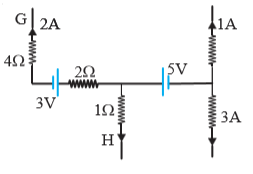If in the circuit shown below, the internal resistance of the battery is 1.5Ω and VP and VQ are the potential at P and Q respectively, what is the potential difference between the point P and Q?

The correct Answer is:D
Step by step video & image solution for If in the circuit shown below, the internal resistance of the battery is 1.5 Omega and V_(P) and V_(Q) are the potential at P and Q respectively, what is the potential difference between the point P and Q? by Physics experts to help you in doubts & scoring excellent marks in Class 12 exams.
Updated on:21/07/2023Topper's Solved these Questions
- ELECTRIC CURRENT & CIRCUITSBOOK - CENGAGE PHYSICS ENGLISHCHAPTER - ELECTRIC CURRENT & CIRCUITSEXERCISE - Kirchhoff s Law and Grouping Cells
15 Videos
- COULOMB LAW AND ELECTRIC FIELDBOOK - CENGAGE PHYSICS ENGLISHCHAPTER - COULOMB LAW AND ELECTRIC FIELDEXERCISE - Single Answer Correct Type
22 Videos
- ELECTRIC CURRENT AND CIRCUITBOOK - CENGAGE PHYSICS ENGLISHCHAPTER - ELECTRIC CURRENT AND CIRCUITEXERCISE - Interger
8 Videos
Similar Questions
In the follwing circuit , the potential difference betweenn P and Q si

View SolutionIn Figure if the potential at Point P is 100V, what is the potential at point Q?

View SolutionIn the circuit shown, what is the potential different VPQ ?

View SolutionFor the given circuit, if internal resistance of cell is 1.5Ω thenVp−Vq is equal to:

View SolutionThe potential difference between the points P and Q in the adjoining circuit will be-

View SolutionConsider the circuit shown below where all resistors are of 1kΩ

If a current of magnitude 1 mA flows through the resistor marked X, what is the potential difference measured between point P and Q ?
View SolutionIn the part of a circuit shown in fig. 5.266, the potential difference (VG−VH) between points G and H will be

View SolutionIn the circuit shown as potential difference of 60V is appliled across AB. The potential difference between the points M and N is

View SolutionIn the circuit shown, the potential differences, V1 ( between A and B ) and V2 ( between C and D ), are

View SolutionIn the part of a circuit shown in figure, the potential different
(VG−VH) between points G
View Solution